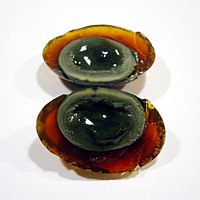
Photo from wikipedia
The intake of phenolic-rich foods is an emerging preventive approach for the management of type 2 diabetes, thanks to the ability of these compounds to inhibit some key metabolic enzymes.… Click to show full abstract
The intake of phenolic-rich foods is an emerging preventive approach for the management of type 2 diabetes, thanks to the ability of these compounds to inhibit some key metabolic enzymes. In this study, the influence of cooking and in vitro digestion on the α-glucosidase, α-amylase, and dipeptidyl-peptidase IV (DPP-IV) inhibitory activity of red-skinned onion (RSO) and dark purple eggplant (DPE) phenolic fractions was assessed. The applied cooking procedures had different influences on the total and individual phenolic compounds gastrointestinal bioaccessibility. DPE in vitro digested phenolic fractions displayed no inhibitory activity versus α-amylase and DPP-IV, whereas the fried DPE sample exhibited moderate inhibitory activity against α-glucosidase. This sample mainly contained hydroxycinnamic acid amides that can be responsible for the observed effect. Contrariwise, raw and cooked in vitro digested RSO phenolic fractions inhibited all three enzymes but with different effectiveness. Fried and raw RSO samples were the most active against them. Statistical analysis pointed out that quercetin mono-hexosides (mainly quercetin-4′-O-hexoside) were responsible for the inhibition of α-glucosidase, whereas quercetin di-hexosides (mainly quercetin-3-O-hexoside-4′-O-hexoside) were responsible for the DPP-IV-inhibitory activity of RSO samples. An accurate design of the cooking methods could be essential to maximize the release of individual phenolic compounds and the related bioactivities.
Journal Title: Foods
Year Published: 2022
Link to full text (if available)
Share on Social Media: Sign Up to like & get
recommendations!